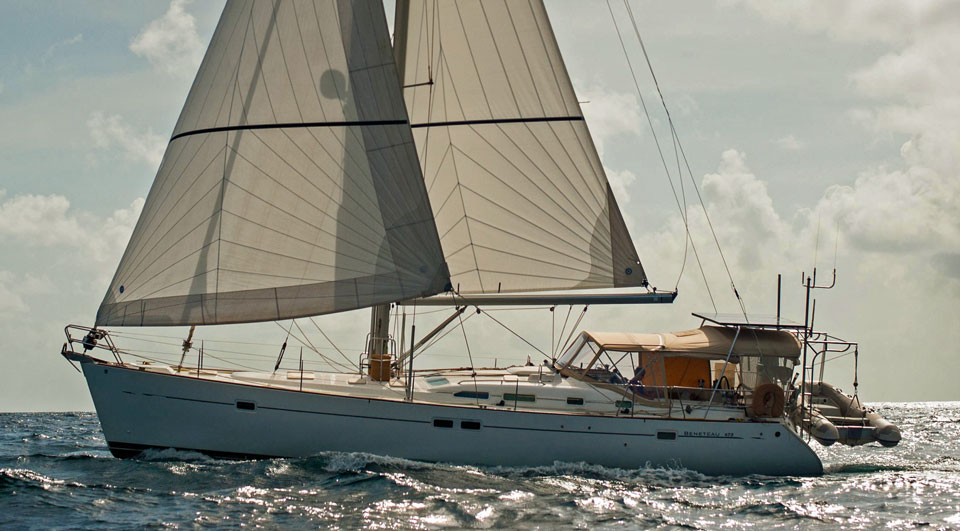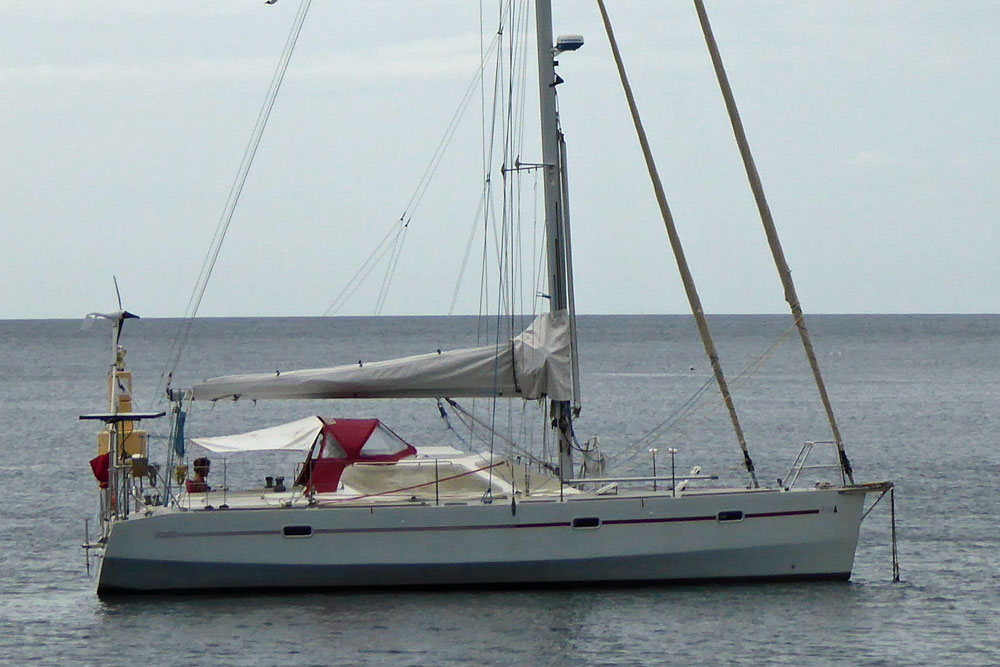Sailboat Construction Materials: From Traditional Wood to Modern Composites
In a Nutshell
Sailboat construction materials have evolved significantly, moving from traditional wood to modern composites, metals, and even ferrocement. Each material and construction method has a profound influence on a sailboat's design, performance characteristics, and maintenance needs.
While materials like GRP (fiberglass) dominate the production boat market for their consistency and low cost, materials such as steel and aluminum are favored by one-off and custom builders for their strength and durability, particularly in larger cruising yachts. The choice of material is a fundamental decision that dictates a boat's ultimate purpose and how it'll perform on the water.
Table of Contents
A Closer Look at Hull Materials & Their Influence on Design
As an experienced cruising sailor of a certain vintage, I've had the opportunity to sail boats made from a wide range of materials. From a cedar-strip planked hull to a heavy displacement steel cruiser, each boat felt unique not just in its handling but also in its fundamental character. The hull material is the very foundation of a sailboat, and it's a choice that impacts everything from the boat's stiffness and weight to its maintenance requirements and resale value.
**********
GRP (Glass Reinforced Plastic)
GRP, commonly known as fiberglass, is the king of modern production boatbuilding. Its popularity stems from the ability to create complex shapes consistently and efficiently using molds. This allows for high-volume production, which in turn makes sailboats more accessible.
Construction: Layers of glassfiber mat and woven rovings are saturated with a polyester or vinyl ester resin. The process can be done by hand lay-up or with more advanced techniques like vacuum bagging for a stronger, lighter laminate.
Design Influence: The consistency of GRP allows for highly refined hull forms with smooth curves and integrated deck structures. Designers can incorporate internal liners and structural grids that are molded in to create a rigid, unified structure.
Pros & Cons:
- Pros: It's easy to repair, requires low maintenance compared to wood, and production boats have consistent quality.
- Cons: It can suffer from osmosis (water absorption into the laminate), can be prone to "print-through" of the internal structure, and older hulls may lose stiffness over time.
**********
Metals: Steel & Aluminum
Metal hulls are a favorite among circumnavigators and self-builders for their strength, rigidity, and impact resistance.
Steel: A cost-effective and robust material, steel is commonly used for larger displacement cruising boats over 45 feet.
- Construction: Hulls are typically built using welded steel plates. Designs often feature multi-chine or rounded forms to reduce welding and create a more hydrodynamic shape.
- Design Influence: The weight of steel favors displacement hulls, making for a comfortable ride in rough seas. However, the need for welding and plate forming can limit complex curves, often leading to a chined hull design.
Pros & Cons:
- Pros: It's exceptionally strong, inexpensive, and easy to modify and repair with welding.
- Cons: It's susceptible to corrosion, requires diligent painting and maintenance, and it's heavy, making it unsuitable for smaller, performance-oriented boats.
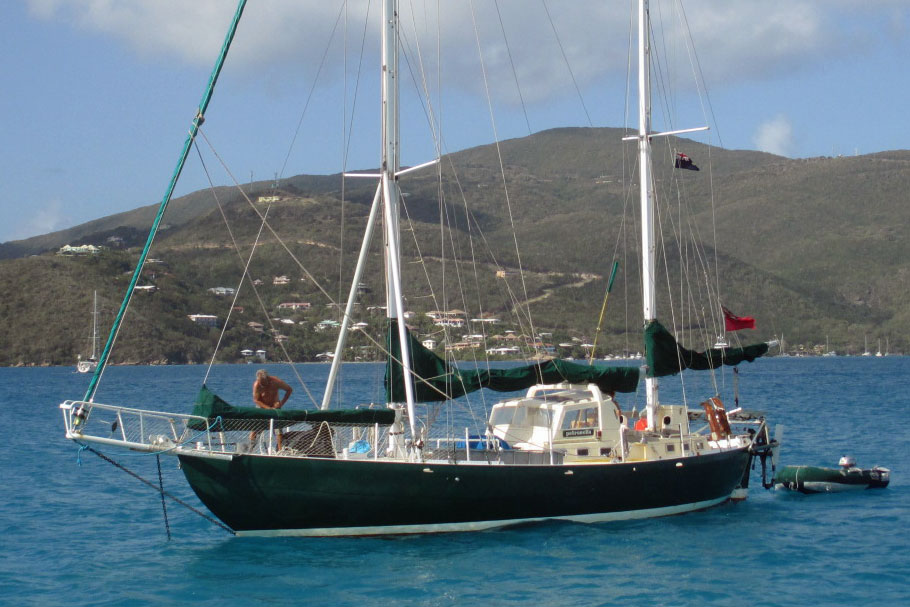 A Joshua 42 steel-hulled sailboat
A Joshua 42 steel-hulled sailboat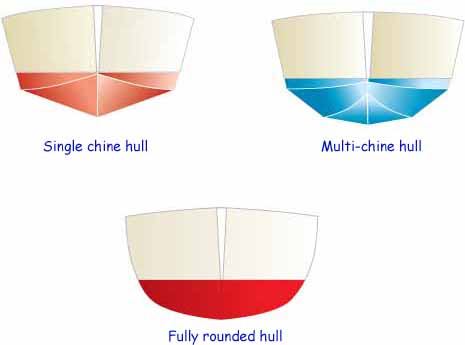 The three common forms of metal hull construction
The three common forms of metal hull constructionAluminium: Lighter than steel with a better strength-to-weight ratio, aluminium is an excellent choice for a rugged cruising boat.
- Construction: Requires specialized welding techniques and equipment. The material is often left unpainted above the waterline, as it forms a protective oxide layer.
- Design Influence: Designers can create lighter, faster, and more efficient cruising boats. The material’s properties allow for more complex chined shapes than steel, and its stiffness means less internal framing is required.
Pros & Cons:
- Pros: It's very strong, naturally resistant to saltwater corrosion, and has an excellent strength-to-weight ratio.
- Cons: It's susceptible to galvanic corrosion from dissimilar metals, is an expensive material, and requires specialized welding.
**********
Wood
Traditional wooden boatbuilding is a craft in itself. Today, modern techniques like cold-molding and strip-planking have revitalized wood as a high-performance and durable material. My own 38-foot self-build cutter, 'Alacazam', was built with strip-planked Western Red Cedar and sheathed in epoxy and bi-axial woven glass rovings, a method that creates a hull that is both light and incredibly stiff.
Construction:
- Strip-Planking: Thin strips of wood are glued edge-to-edge over a temporary frame. The entire structure is then sheathed in fiberglass cloth and epoxy resin, creating a composite hull.
- Cold-Molding: Layers of thin veneers are laid diagonally over a mold and bonded with epoxy. This creates a monocoque structure that's exceptionally strong.
- Design Influence: Modern wood construction allows for beautiful, complex curves. The resulting hulls are often lighter and stiffer than their GRP counterparts, offering a superior sailing experience.
Pros & Cons:
- Pros: It has a high strength-to-weight ratio, excellent stiffness, and a warm and aesthetically pleasing interior.
- Cons: It requires skilled craftsmanship, can be labor-intensive, and traditional wood boats are susceptible to rot if not properly maintained.
**********
Ferrocement
This is a niche material for the determined self-builder. Ferrocement involves a framework of steel mesh and reinforcing rods plastered with a sand-and-cement mortar.
Construction: The hull shape is formed by a complex lattice of steel mesh and rods, which is then covered with a mixture of cement, sand, and water.
Design Influence: Due to its weight, ferrocement is best suited for heavy displacement cruising hulls. Its malleability allows for rounded, traditional hull forms without the need for complex plate forming.
Pros & Cons:
- Pros: The materials are inexpensive, and it has very high impact resistance.
- Cons: It's extremely heavy, labor-intensive to build, prone to quality control issues if not built by an expert, and can be difficult to insure or resell.
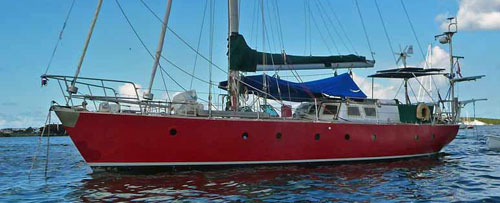 'Meteor', a ferrocement cutter
'Meteor', a ferrocement cutter| Material | Primary Use | Key Characteristics | Best Suited For |
|---|---|---|---|
| GRP | Mass Production | Consistent, low maintenance, customizable molds. | Recreational & production cruisers/racers. |
| Steel | Custom & One-Offs | Durable, impact-resistant, heavy. | Heavy displacement, long-distance cruising yachts (over 45'). |
| Aluminum | Custom & One-Offs | Strong, lightweight, corrosion-resistant. | Performance-oriented expedition & cruising yachts. |
| Wood | Custom & Self-Build | Stiff, light, beautiful. | Performance cruisers & classic yachts. |
| Ferrocement | DIY & Budget Builds | Inexpensive materials, very heavy, strong. | Displacement cruising yachts for budget-conscious builders. |
Other Materials & Structural Considerations
Sandwich Composite Construction
While GRP is the most common material for production boats, many modern performance yachts use a more advanced technique called sandwich composite construction. This method involves a lightweight core material, like foam or balsa wood, sandwiched between two layers of GRP laminate. This creates a much stiffer and lighter structure than a solid laminate hull. The stiffness allows for a greater sail plan and a lighter displacement, both of which improve speed.
A sailboat's physical structure is just one part of its story. Naval architects also rely on a series of mathematical design ratios to predict a vessel's speed, stability, and handling characteristics. To dive deeper into how these numbers influence a boat's performance and safety, be sure to read our detailed guide "Mastering Sailboat Design Ratios & Regulation for Performance & Safety".
This article was written by Dick McClary, RYA Yachtmaster and author of the RYA publications 'Offshore Sailing' and 'Fishing Afloat', member of The Yachting Journalists Association (YJA), and erstwhile member of the Ocean Cruising Club (OCC).
Frequently Asked Questions
What is a "monocoque" hull?
What is a "monocoque" hull?
A monocoque hull is a type of construction where the outer shell of the boat supports all the loads and stresses, similar to an eggshell. This method eliminates the need for a separate internal frame, making the boat lighter and stronger.
Is a GRP hull better than a steel hull for offshore sailing?
Is a GRP hull better than a steel hull for offshore sailing?
It's not a matter of "better," but of different characteristics. A GRP hull can be fast and efficient, while a steel hull offers superior impact resistance against floating debris or ice. The choice depends on the type of sailing you plan to do.
Why is wood construction so popular for custom boats?
Why is wood construction so popular for custom boats?
Modern wood construction techniques, like cold-molding and strip-planking, allow for the creation of incredibly stiff and lightweight hulls with a high degree of design flexibility. They also offer a unique aesthetic and a warm interior feel.
How do materials influence the cost of a sailboat?
How do materials influence the cost of a sailboat?
The choice of material significantly impacts cost. GRP is generally the most economical for production boats due to the efficiency of molding. Aluminum is expensive due to the high material cost and specialized welding, while steel is a more affordable metal option. Wood's cost can vary widely depending on the type of wood and the complexity of the build.
Resources Used:
- Ferrocement Boatbuilding by Gavin, John: https://www.boatdesign.net/ferro/ferro-3.pdf
- The Elements of Boat Strength by Dave Gerr: https://www.gerrmarine.com/ELEMENTS_OF_BOAT_STRENGTH.html
- The Gougeon Brothers on Boat Construction by Meade Gougeon and Joel Gougeon: https://soundingsonline.com/features/glued-together/
Recent Articles
-
Yacht Clearance in the Caribbean: A Sailor's Guide
Nov 25, 25 07:13 AM
Navigating yacht clearance in the Caribbean is essential for a smooth sailing trip. This guide, written by an experienced sailor, explains the required papers, procedures & tips for a hassle-free expe… -
Beneteau Oceanis 36CC: Specs, Ratios & Cruising Suitability
Nov 25, 25 06:08 AM
Detailed analysis of the Beneteau Oceanis 36CC centre cockpit sailboat. Includes design ratios, full specifications, and practical assessment of its suitability for experienced offshore and liveaboard… -
Essential Boat Toilet Maintenance & Systems: A Sailor’s Guide
Nov 24, 25 01:17 PM
Master boat toilet maintenance, from manual sea heads to 12v electric systems. Get an experienced offshore sailor’s guide on avoiding clogs, leaks, & bad smells.
